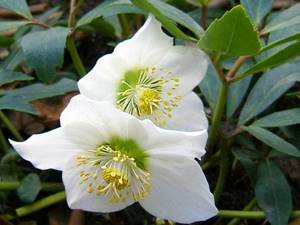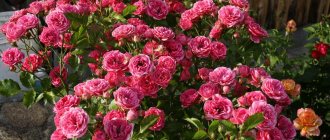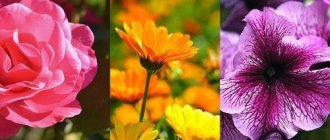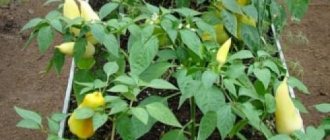Flower beds of white perennials: features
Each flower has its own magic, which evokes certain emotions and states of mind. But lightness, elegance and purity are what is inherent in the white shade. Growing such flowers will make the area allocated for the flower garden visually larger. Landscape designers are convinced that the ideal place for growing such crops is a recreation area or an area near water bodies. In this case, you can experience peace.
Attention!
Many summer residents and novice flower growers mistakenly read that it is easy to decorate a flower bed with flowers of the same shade. But in addition to the correct design, you also need to follow the tips for creating a flower garden, thanks to which you will be able to bring your idea to life.
Before you begin developing a flowerbed project, you will need to take into account the following aspects:
- white flowers on the site will look advantageous against the background of a lawn or hedge. But you should avoid planting near bright structures or fences;
- perennials should be at least 50% of the total number of crops planted in the flowerbed. Annuals will complement them well due to their early and longer flowering;
- a flower bed made in the same color scheme should have 3-4 tiers. The former should consist of ornamental grasses, and the latter - of bushes, vines and trees;
- if you decide to plant white perennials on your site, then you need to study in advance what type of soil they prefer, as well as the features of caring for the crop;
- the neighborhood should be with different cultures that differ in form. Thanks to this solution, there will be no monotony in the flower garden;
- one species can be planted in no more than three copies.
In addition, do not forget about the budding period. In one flower bed there can be two plants at the same time, whose growing season occurs during the same period. At the same time, you should not expect that the desired result will appear within a year - this will take at least two seasons. But you will be able to fully enjoy the beauty of the flowerbed about 3 years after its formation.
White spring flowers for the dacha
The flowering of a white garden begins with the earliest white crocuses and, of course, snowdrops. Later, white-flowered primroses and the well-known daffodils bloom. At the beginning of May, the real time for tulips to bloom begins. White tulips can be found both among the usual early and late tulips, and among the lily-flowered, fringed and double species. Blooming fruit trees: cherries, apple trees, pears, plums become an unusual decoration of a white spring garden. Lilies of the valley are blooming like a white carpet under the tree crowns, and tulips are gradually giving way to daisies, dicentra, poultry and the white variety of awl-shaped phlox. At the end of May, white lilacs also bloom with lush inflorescences.
Article on the topic: For beginning builders: how to lay timber correctly?
What is the secret of white permanence for flower beds
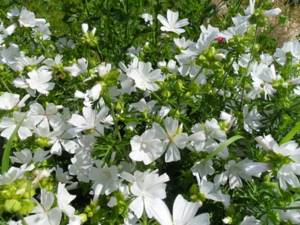
A pure white shade in a summer cottage or garden is quite rare, as is black. Plants are often considered white if they even roughly resemble this palette. So, we are talking about cream, slightly pink, light blue, light green or lilac flowers. But if you compare them with the original, the difference immediately becomes noticeable. The principle of the effect of white flowers is always the same.
Attention!
When creating a flower garden in one color scheme in an area with an emphasis on a white shade, you must remember that such a name is conditional. We are talking about a combination of two different colors, since white is a complement to the brighter one.
Green leaves accentuate the beauty of light colors and make them brighter. If there is a desire to make the flower bed exactly white, then it is necessary to take into account the features of the greenery that can enhance this effect or, on the contrary, will lead to the fact that the predominance of whiteness will be spoiled. When designing bright areas, designers advise also planting coniferous and deciduous shrubs.
A white flower garden will be beautiful if you take care of it in spring and autumn. There are few plants with white flowers, the growing season of which occurs at the beginning and end of the dacha season. The flowerbed will look empty or nondescript before flowering and after they fall, so you need to think in advance about growing crops with bright foliage. In addition, the condition of the flowers must be perfect. You can play on the size of plants, as well as their shapes. Small inflorescences can be combined with large ones.
White flowering perennials - plant names
You can admire the blooming white Rhododendrons for about 3 weeks. Deciduous shrubs have a branched crown; flowering begins in the spring when the buds open and the first leaves appear. Huge white caps of inflorescences cover the bushes like a thick layer of snow.
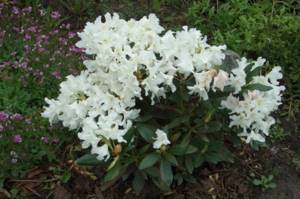
Tree peonies with snow-white double and semi-double inflorescences decorate gardens from the beginning of May and bloom for about 3 weeks. On the lower parts of the white petals of peonies there may be pink areas bordering the core of the flower. After flowering, the bushes of these types of peonies do not dry out, do not shed their leaves, but become ornamental shrubs with beautiful carved leaves.
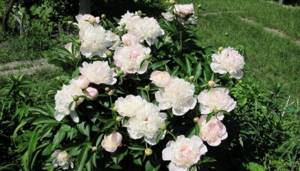
Herbaceous peonies, blooming white, delight their owners in spring and mid-summer. The Rose Marie Lens variety blooms its huge flowers with a diameter of 22 cm in early June. In mid-summer, the peony blooms with white petals and a yellow center, Yellow King. The White Swan variety blooms from the end of May. Terry balls of its flowers will be visible from any corner of the garden. At the end of summer you can admire the flowering of the peony variety Duchess de Nemours.
The flowering of white dahlias of the My Love variety begins to be admired in the summer; the bushes throw out buds until frost.
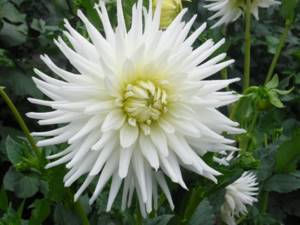
To decorate the borders of paths, snow-white border dahlias of the Wittem variety are used; their flowering also continues until the onset of cold weather. White Esther pompon dahlia is decorated with small white balls. Fringed dahlia Ice Crystal with its lacy edges looks simply captivating.
Advantages and disadvantages of perennials
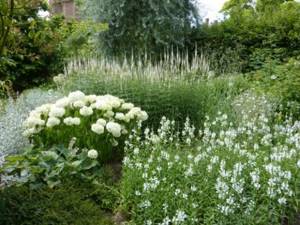
Summer residents often choose perennial flowers for their ease of care and growing conditions. Among ornamental plants, you can choose varieties that bloom in the spring-autumn period and can give the area a well-groomed appearance without the need to constantly water or weed them.
Garden flowers not only decorate the site - they can also bring benefits. As they grow, weeds are crowded out, so the fertile layer of soil is preserved.
Many gardeners are convinced that annual flowers are more beautiful than perennial ones. But this opinion is erroneous and is due to the lack of necessary knowledge about the diversity of perennial shrubs with white flowers. Among them, you can choose those that can intoxicate with their aroma and delight you with a variety of shapes and sizes.
Attention!
If it is necessary to combine annuals and perennials, then the latter should be planted in the back row. It is necessary to start planting with low-growing plants, then move on to medium-growing ones and finish the procedure with tall ones. With this approach, cultures will not block each other.
But, despite the existing advantages, growing perennials also has disadvantages. For example, they grow quickly, so they gradually begin to fill the entire flower garden. To avoid such consequences, you will have to install a fence.
The best perennials with white flowers
It is advisable to choose perennials with white flowers for planting on the site. This will eliminate the need for annual renewal of the flower garden - the plants will grow anyway. Perennials can bloom in spring, summer and autumn.
White perennials blooming in spring
Flowers that bloom in the first days of spring are classified as early bloomers. But at the same time, there are crops that bloom in other spring months, when the earth and air have already warmed up well under the sun.
Snowdrop
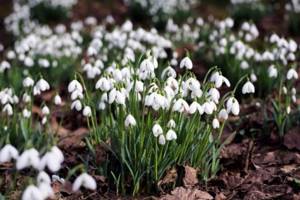
Galanthus is a bulbous crop that begins to grow as soon as the snow melts. The growing season is short, lasting approximately 30 days and occurring in March. Then the upper part dies off and the snowdrop is not visible until next year.
This flower loves areas well lit by the sun, but will also take root in the shade. Grows on any type of soil. Reproduction occurs by bulbs, as well as by seeds carried by ants. In the first case, planting should be done in the fall. And in the spring, after the end of the flowering period, the bushes need to be replanted.
White hellebore
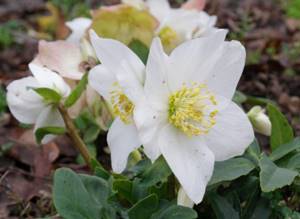
The perennial plant is evergreen and drought tolerant. The white flower does not require special soil; it prefers shade from large trees. The growing season occurs in early spring. The legend says that it can bloom even in January.
Interesting!
There is a legend about how helleborus appeared. It says that a poor shepherd wanted to give a gift to the divine baby, but began to cry because he could not find anything worthwhile. BUT from his words the snow melted, under which the shepherd discovered a beautiful flower.
The drooping inflorescences resemble lanterns, the diameter of which is 80 mm. Look perfect against the backdrop of a snow-covered area. It can grow in one place for a decade. Interest in the culture is also increased by the fact that there are several varieties of it with different shapes and shades, and also has healing properties. Some varieties are poisonous.
White low-growing flowers for a monochrome garden of continuous flowering
Low-growing perennials are an essential element of an alpine hill, borders and flower beds of any shape, the first background of a garden landscape.
When choosing white cover flowers, be sure to make sure they stand out against contrasting design elements. If cover perennials decorate the garden path, then it should be laid out, for example, with red tiles. It is better to build an alpine slide from stone of contrasting tones. As a last resort, highlight the white flowers with a strip of green grass. It’s easy to choose touches of color for white, as it goes well with any other colors.
Saxifraga Schneeteppich
Completely unpretentious low-growing flowers. Among the huge variety of species of this perennial, there are also white varieties. The inflorescences have a diameter of up to 2 cm, the length of the stem reaches a height of 10-20 cm, and, growing profusely, the white small flowers of perennial saxifrage look like delicate lace in any flowerbed. White saxifrage can be sown in a flower bed as a living carpet, alternating a pattern of small flowers with green grass. True, this perennial sprouts only after a year, so to accelerate growth, it is better to plant it in seedlings in the first year. Flowering period is May-June.

Lily of the valley Dorien
Lily of the valley blooms before saxifrage. In warm regions, its flowering may begin in the last ten days of April. As already mentioned, it has a powerful root system that can occupy the entire area in a couple of years. The delicate flower is completely undemanding to care and has a delicate aroma. The only condition for a white perennial is to limit the space for its growth. If there is soil on the site that needs strengthening, then this fragile-looking perennial will help solve the problem of erosion. Lilies of the valley easily tolerate shade and waterlogged soil, so they can also decorate the shore of a small home pond.

White anemone or anemone Nemorosa white
The tender early flower has many names, and its origin is connected with the biblical legend that God showed mercy by expelling sinful ancestors from the ever-blooming garden and turned icy snowflakes into white flower petals so that Eve would not shiver from the cold as she left the Garden of Eden. Snowdrop, goat, freckle, buttercup are the popular names for oak anemone. The name Nemorosa white, translated from Greek, means “daughter of the winds.”
The white flowers of oak anemone are one of the types of early perennials in the wild. There are garden varieties that are not only white, but also yellow, red, pinkish and purple in color. Anemone is a very delicate plant, despite its cold resistance: if one flower is picked, the entire bush dies. Moreover, anemone can live in one place for 40-50 years! Blooms from August to October. The flower tolerates shade, but for early flowering it needs an area that is most illuminated by the sun.
Anemone has universal medicinal properties; back in the Middle Ages it was used for healing infusions and decoctions, which is why it has become a rare, endangered species. White anemone flowers will not only decorate the garden as soon as the snow melts, but can also serve as an emergency aid in the treatment of infectious and colds.
Attention! Nemorosa white anemone is not used for treatment by official medicine, and an overdose of folk remedies can cause poisoning.
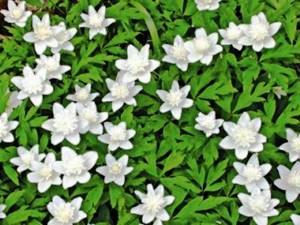
White hellebore
Helleborus or Christmas rose is a flower that begins to bloom sooner or later. A representative of the buttercup family, according to legend, is capable of blooming even in January, around Christmas. The legend says that a poor shepherd wanted to bring a worthy gift to the divine baby, but could not find anything and began to cry out of despair. His tears melted the snow and he saw a beautiful flower.
What else is interesting about hellebore? Of course, because there are several types of it with different shades and shapes, but also because the Christmas rose has healing properties. Some of its species are poisonous. White hellebore grows up to 50 cm in height. Looks very impressive in a group planting. Propagated by dividing the bush, but does not like too frequent transplants. Therefore, it is important to select a suitable place for it in advance, in the shade of deciduous trees. Hellebore loves moist soil.
The first flowers in the middle zone appear in April; in warmer regions it can bloom much earlier. To prevent such an early flower from being lonely in the garden, supplement it with early bulbous flowers.
